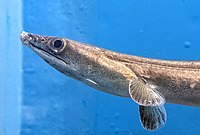bio.wikisort.org - Animal
The daggertooth pike conger (Muraenesox cinereus) or the darkfin pike eel,[2] is a species of eel in the pike conger family, Muraenesocidae.[3] They primarily live on soft bottoms in marine and brackish waters down to a depth of 800 m (2,600 ft), but may enter freshwater.[3] They commonly grow to about 1.5 m (4.9 ft) in length,[4] but may grow as long as 2.2 m (7.2 ft).[3] Daggertooth pike congers occur in the Red Sea, on the coast of the northern Indian Ocean, and in the West Pacific from Indochina to Japan. It has also invaded the Mediterranean through the Suez Canal.[4]
| Daggertooth pike conger | |
|---|---|
| Scientific classification | |
| Kingdom: | Animalia |
| Phylum: | Chordata |
| Class: | Actinopterygii |
| Order: | Anguilliformes |
| Family: | Muraenesocidae |
| Genus: | Muraenesox |
| Species: | M. cinereus |
| Binomial name | |
| Muraenesox cinereus | |
| Synonyms | |
|
Muraena cinerea Forsskål, 1775 | |
Culinary uses

Daggertooth pike conger is a major commercial species, with annual catches reaching about 350,000 tonnes in recent years. The spot reporting the largest landings was Taiwan Province of China.[4] It is eaten in Japanese cuisine, where it is known as hamo (ハモ, 鱧).[5] In the Kansai Region, hamo no kawa (pickled conger skins) is a traditional delicacy,[citation needed] and pike conger is a common ingredient in some types of kamaboko (fish cake).[6][7]
Parasites
As other fish, the daggertooth pike conger harbours several species of parasites.
A species of trichosomoidid nematode which parasitizes the muscles of the fish off Japan has been described in 2014 and named Huffmanela hamo, in reference to the Japanese name of the fish.[8] Accumulations of eggs of the parasite are visible as 1–2 mm black spots in the flesh of the fish. The parasite is rare and the consumption of infected fish meat has no consequences for humans.
Gallery
- Specimen seen at Nagasaki Penguin Aquarium
 Illustration
Illustration- Hamo with pickled plum
- Eggs of Huffmanela hamo in muscles
References
- "Muraenesox cinereus". Integrated Taxonomic Information System.
- Bray, Dianne J. "Muraenesox cinereus". Fishes of Australia. Retrieved 4 Sep 2022.
- Froese, Rainer; Pauly, Daniel (eds.) (2012). "Muraenesox cinereus" in FishBase. September 2012 version.
- "Muraenesox cinereus (Forsskal, 1775)". Species Fact Sheets. FAO Fisheries and Aquaculture Department. 2012.
- Davidson, Alan (2003). Seafood of South-East Asia: a comprehensive guide with recipes. Ten Speed Press. p. 34. ISBN 1-58008-452-4.
- "かまぼこ製品図鑑 [Kamaboko Products]". 日本かまぼこ協会 [Japan Kamaboko Association]. Archived from the original on 2020-02-27. Retrieved 25 March 2021.
- "かまぼこの種類と歴史 [History and Types of Kamaboko]". 上野屋蒲鉾店 [Uenoya Kamaboko]. Archived from the original on 2007-01-10. Retrieved 25 March 2021.
- Justine, J.-L. & Iwaki, T. 2014: Huffmanela hamo sp. n. (Nematoda: Trichosomoididae: Huffmanelinae) from the dagger-tooth pike conger Muraenesox cinereus off Japan. Folia Parasitologica, 61, 267–271 doi:10.14411/fp.2014.029 Free PDF

External links
Другой контент может иметь иную лицензию. Перед использованием материалов сайта WikiSort.org внимательно изучите правила лицензирования конкретных элементов наполнения сайта.
WikiSort.org - проект по пересортировке и дополнению контента Википедии



